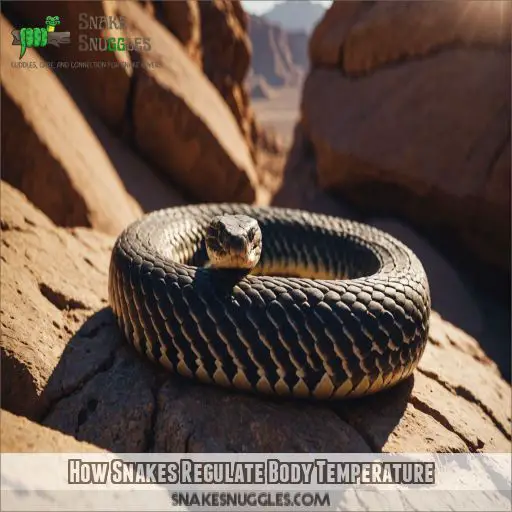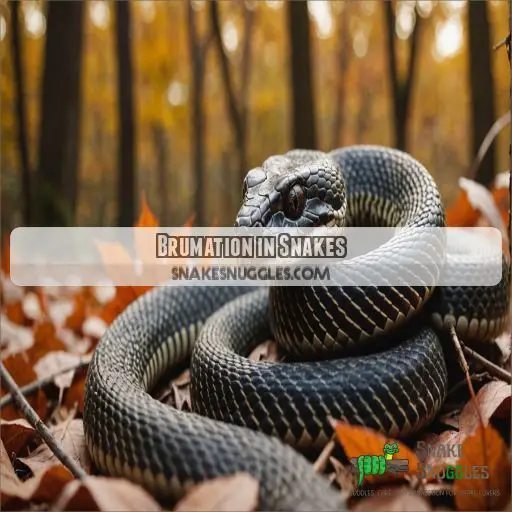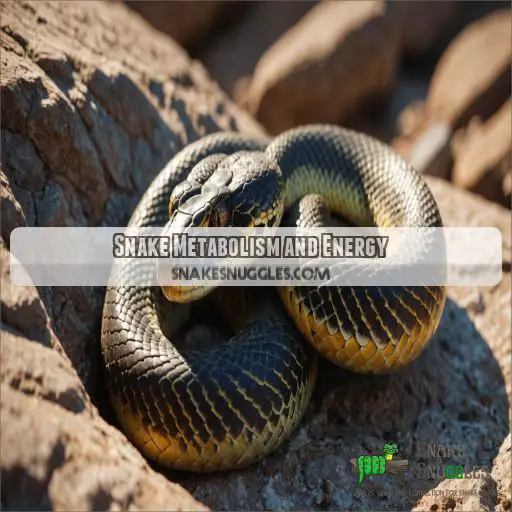This site is supported by our readers. We may earn a commission, at no cost to you, if you purchase through links.
 You’re curious about why snakes are cold-blooded? Well, it’s not because they’re chilly creatures by nature! The truth is, snakes, like all reptiles, are ectothermic, meaning they get their temperature from their surroundings.
You’re curious about why snakes are cold-blooded? Well, it’s not because they’re chilly creatures by nature! The truth is, snakes, like all reptiles, are ectothermic, meaning they get their temperature from their surroundings.
This adaptation helps them thrive in various climates, from scorching deserts to chilly oceans. By relying on external heat sources, snakes conserve energy and stay efficient.
Being cold-blooded doesn’t mean they’re sluggish or slow – quite the opposite! Snakes have clever behavioral adaptations to regulate their temperature, and you’ll discover just how they do it as you explore the fascinating world of reptile thermoregulation.
Table Of Contents
- Key Takeaways
- Evolution of Ectothermy
- How Snakes Regulate Body Temperature
- Brumation in Snakes
- Snake Metabolism and Energy
- Snakes in Extreme Temperatures
- Debunking Common Myths
- Frequently Asked Questions (FAQs)
- Why did reptiles evolve to be cold-blooded?
- Why don’t snakes produce heat?
- How do snakes survive extreme cold?
- Can snakes survive in the heat?
- Are all reptiles, including snakes, truly cold-blooded animals ?
- How does a snakes cold-blooded nature affect its habitat preferences ?
- Can cold-blooded animals, like snakes, ever feel cold or warm ?
- How do cold-blooded animals regulate their body temperature over time ?
- Are there any exceptions to reptiles being cold-blooded ?
- Conclusion
Key Takeaways
- You might be surprised to learn that snakes aren’t actually "cold-blooded" in the classical sense—they’re ectothermic, meaning they rely on external heat sources to regulate their body temperature. This clever adaptation helps them conserve energy and thrive in diverse environments.
- As an ectotherm, a snake’s metabolism is directly influenced by its environment, which means their energy needs are surprisingly low. They don’t burn energy to stay warm, so they don’t need to eat as often—a handy trick for surviving in areas with limited food sources!
- Snakes have evolved some amazing strategies to cope with extreme temperatures, from producing antifreeze-like substances to prevent ice crystals from forming in their bodies to seeking shade and adjusting their activity patterns to avoid heat stress. Talk about being adaptable!
- Being "cold-blooded" doesn’t mean snakes are sluggish or slow—quite the opposite! They’re masters of thermoregulation, using external heat sources, behavioral adaptations, and physiological responses to maintain a suitable body temperature and stay cozy and healthy.
Evolution of Ectothermy
When you’re learning about reptiles, you might wonder why snakes are often called "cold-blooded" – a term that’s actually a bit misleading (Source). In reality, reptiles like snakes have evolved to be ectothermic, meaning they rely on external heat sources to regulate their body temperature, and this unique approach has its advantages and disadvantages (Source).
Why Did Reptiles Evolve to Be Ectothermic?
You’re about to uncover the secrets behind reptiles’ ectothermic nature. It’s believed that reptiles evolved to be ectothermic due to environmental pressures, allowing them to thrive in various climates. This survival strategy relies on external heat sources, making them energy-efficient and adaptable to their surroundings (Source).
Advantages of Ectothermy in Reptiles
As you explore reptiles, you’ll discover the advantages of ectothermy. With lower energy needs, reptiles can thrive in diverse habitats, from deserts to oceans. This adaptation has led to fascinating survival strategies, like snake venom, which has also contributed to medical science.
-
- Energy efficiency: Reptiles conserve energy by regulating their body temperature using external sources.
-
- Habitat diversity: Ectothermy allows reptiles to inhabit a wide range of environments, from the frozen tundra to the scorching deserts.
-
- Survival strategies: Reptiles have evolved unique survival strategies, like hibernation and brumation, to cope with extreme temperatures.
-
- Physiological advantages: Ectothermy has led to physiological advantages, such as slower aging and increased resistance to diseases.
Disadvantages of Ectothermy in Reptiles
Now that we’ve explored the advantages of ectothermy, let’s talk about the downsides. As a reptile, being ectothermic comes with its fair share of challenges. Take a look at this table to get an idea of what I mean:
| Thermoregulation Challenges | Effects on Reptiles | Real-Life Implications |
|---|---|---|
| Limited Geographic Range | Reduced habitat options | Less space to roam and find food |
| Metabolic Rate Fluctuations | Unpredictable energy levels | Harder to hunt and survive |
| Cold Stress Vulnerability | Increased risk of illness | More susceptible to diseases like Lyme disease |
| Activity Level Constraints | Limited mobility and foraging | Reduced ability to find food and escape predators |
| Heat Source Dependence | Need for radiant or convective heat | Vulnerable to heat source disruptions |
These challenges highlight why the "cold-blooded" myth is misleading. Ectothermy is a complex trait that comes with its own set of advantages and disadvantages.
How Snakes Regulate Body Temperature
You’re about to discover how snakes regulate their body temperature, a vital aspect of their survival. As an ectothermic species, snakes rely on external heat sources, clever behavioral adaptations, and physiological responses to maintain a suitable body temperature, and we’re about to explore these fascinating strategies.
External Heat Sources for Snakes
Now that you know why reptiles evolved to be ectothermic, let’s explore how snakes regulate their body temperature using external heat sources. You see, snakes are experts at soaking up the heat!
- Basking in the warmth of a rock or sandy beach on a sunny day
- Coiling up near a snake heat lamp to absorb its radiant heat
- Slithering into a warm patch of sunlight filtering through the trees in a forest
Behavioral Adaptations for Temperature Regulation
You might be surprised to learn that snakes are masters of thermoregulation. They regulate their body temperature through clever behavioral adaptations, such as basking in the sun, seeking shelter in cooler spots, and adjusting their activity patterns to avoid extreme temperatures, all to stay cozy and healthy.
Physiological Responses to Temperature Changes
You see, snakes have some nifty physiological tricks up their sleeves to cope with temperature fluctuations. Their thermoregulation mechanisms kick in, triggering a heat shock response to hot temps and cold stress adaptation to chilly ones. Temperature sensing pathways help them adjust their metabolic rate to stay cozy.
Brumation in Snakes
As you explore the fascinating world of snakes, you’ll discover that brumation is an important survival strategy that helps them cope with cold temperatures. In this section, we’ll uncover the ins and outs of snake brumation, including how they prepare for it, where they shelter, and how long they stay in this state of dormancy.
What is Brumation in Snakes?
You might wonder, what’s brumation in snakes? Simply put, it’s a deep sleep-like state snakes enter to conserve energy during cold temperatures, differing from hibernation in that they don’t eat or drink during this period.
How Do Snakes Prepare for Brumation?
As winter approaches, you might wonder how snakes prepare for brumation. It’s a big deal for them, a process that involves responding to environmental cues, selecting shelter, reducing food intake, and slowing down their metabolism to conserve energy.
- Environmental cues: Snakes respond to shorter days, cooler temperatures, and reduced humidity, signaling them to prepare for brumation.
- Food reduction: Snakes eat less or stop eating altogether to slow down their metabolism and conserve energy.
- Metabolic slowdown: Snakes’ heart rates and breathing slow down, allowing them to conserve energy during the cold winter months.
- Hibernation vs. brumation: Unlike true hibernation, snakes don’t experience a deep, long-term sleep, but rather a period of reduced activity and lowered body temperature.
Brumation Sites and Shelter for Snakes
Now that you know how snakes prepare for brumation, let’s explore where they snooze the winter away. When selecting a brumation site, snakes often opt for cozy spots like underground burrows, hollow logs, or rock crevices that shield them from harsh winter conditions.
Duration and Emergence From Brumation
You’re probably wondering how long snakes stay in brumation. The duration varies depending on the species and climate. Here are some general guidelines:
- Short brumation: Some species, like garter snakes, brumate for only 2-3 months.
- Medium brumation: Others, like rattlesnakes, can brumate for 4-6 months.
- Long brumation: Some snakes, like the common viper, can stay in brumation for up to 8 months.
- Emergence cues: Snakes typically emerge from brumation when temperatures rise and daylight hours increase.
Snake Metabolism and Energy
As you explore the fascinating world of snakes, you’ll discover that their ectothermic nature has a significant impact on their metabolism and energy expenditure. In this section, we’ll break down how being "cold-blooded" affects a snake’s metabolic rate, energy needs, and food requirements, giving you a deeper understanding of these incredible creatures.
How Does Ectothermy Affect Snake Metabolism?
You’re probably curious about how ectothermy impacts snake metabolism. Well, let’s break it down! As an ectothermic animal, a snake’s metabolism is directly influenced by its environment. Here’s a simple table to illustrate this:
| Temperature | Metabolic Rate |
|---|---|
| Low | Slow |
| Ideal | Moderate |
| High | Fast |
| Extreme | Critically slow/fast |
This table shows how temperature affects a snake’s metabolic rate. Since snakes rely on external heat sources, their metabolism adjusts accordingly. When it’s cold, their metabolism slows down, and when it’s warm, it speeds up. This unique adaptation helps them conserve energy.
Energy Expenditure in Snakes
As you explore snake metabolism, you’ll discover that their energy expenditure is surprisingly low. This is due to their ectothermic nature, which means they don’t burn energy to stay warm. Here are some factors that influence a snake’s energy requirements:
- Body size: Larger snakes need more energy to move and hunt.
- Environmental factors: Temperature, humidity, and terrain affect a snake’s activity levels and energy needs.
- Age and growth rate: Younger snakes require more energy to fuel their rapid growth.
- Reproductive status: Pregnant or breeding snakes have higher energy demands.
Food Requirements for Snakes
When it comes to food, snakes have unique needs. Their ectothermic nature means a lower metabolic rate, so they don’t need to eat as often. Prey size, feeding frequency, and nutritional needs vary by species, but generally, snakes have a slower digestion rate, making meals a less frequent affair.
Snakes in Extreme Temperatures
As you explore the fascinating world of snakes, you’ll discover that their ability to survive in extreme temperatures is quite impressive. From the freezing cold to scorching heat, snakes have adapted remarkable strategies to regulate their body temperature and thrive in diverse environments .
How Do Snakes Survive Extreme Cold?
You might wonder, how do snakes survive extreme cold? Well, they don’t exactly "hibernate" like mammals, but rather brumate – a state of dormancy where their metabolism slows down. They also produce antifreeze-like substances to prevent ice crystals from forming in their bodies, conserving energy for survival.
Can Snakes Survive in High Temperatures?
You’re probably wondering if snakes can handle the heat.
The answer is yes!
Many snakes, especially desert-dwelling species, have impressive heat tolerance.
They employ clever strategies like seeking shade, burrowing, and adjusting their activity patterns to cope with high temperatures.
Desert snakes, in particular, have adapted to high temperatures.
They use heat-seeking strategies to regulate their body temperature, often basking in the sun or seeking shade to avoid heat stress.
Temperature Tolerance in Different Snake Species
You’re probably wondering how different snake species handle extreme temperatures. Well, it’s quite fascinating! Snakes in various geographic locations have adapted to their local temperature variations . For instance, the hot-spring snake has evolved to thrive in temperatures that would be lethal to other species .
Debunking Common Myths
You’ve probably heard it before: snakes are "cold-blooded," implying they’re sluggish and can’t control their body temperature. But, as we’ll explore in this section, that’s a common myth – snakes are actually ectothermic, meaning they rely on external heat sources to regulate their body temperature, and they’re pretty good at it too!
Are Snakes Really Cold-Blooded?
You’ve likely heard snakes are "cold-blooded," but what does that really mean? Let’s set the record straight:
- Snakes aren’t always cold: They can reach high body temperatures, especially in warm environments.
- Ectothermy isn’t the same as cold-blooded: Snakes regulate their temperature using external sources.
- Temperature control is key: Snakes have a thermal optimum, and they seek out environments to reach it.
Do Snakes Produce Heat Internally?
You’re wondering if snakes produce heat internally? Well, the answer is no! As ectotherms, snakes rely on external heat sources to regulate their body temperature. Their metabolism is adapted to conserve energy, and they don’t generate heat internally like endothermic animals do. This unique approach has its advantages!
Separating Fact From Fiction in Snake Thermoregulation
Now that we’ve busted the myth about snakes producing heat internally, let’s separate fact from fiction in snake thermoregulation. Here are some common misconceptions:
- Snakes are cold-blooded and can’t regulate their body temperature.
- Hibernation and brumation are the same thing.
- Ectothermy means reptiles are sluggish and slow.
Frequently Asked Questions (FAQs)
Why did reptiles evolve to be cold-blooded?
You’ll be surprised to know that reptiles, including snakes, have a metabolic rate about 1/7th that of similarly sized mammals! They evolved to be ectothermic, relying on external heat sources, which conserves energy and allows them to thrive in various environments.
Why don’t snakes produce heat?
You might be wondering, why don’t snakes produce heat? Well, as ectothermic animals, snakes rely on external heat sources to regulate their body temperature, rather than generating heat internally like mammals and birds do .
How do snakes survive extreme cold?
You’re wondering how snakes survive extreme cold? Well, they’re experts at hiding and conserving energy! Snakes will burrow underground, hide in rocky crevices, or even gather in large groups to share body heat .
Can snakes survive in the heat?
As you slither into the scorching summer, you wonder, can snakes survive in the heat? Fortunately, snakes are surprisingly skilled at regulating their body temperature, often seeking shade or cooler spots to chill out.
Are all reptiles, including snakes, truly cold-blooded animals ?
You’re about to uncover a myth-busting truth! Not all reptiles, including snakes, are truly ‘cold-blooded.’ They’re actually ectothermic, meaning their body temperature is regulated by the environment, and they can get pretty warm when they need to.
How does a snakes cold-blooded nature affect its habitat preferences ?
Picture a snake as a master thermostat, seeking its sweet spot – just like Goldilocks, not too hot, not too cold. As an ectotherm, it regulates its body temperature using external sources, affecting its habitat preferences.
Can cold-blooded animals, like snakes, ever feel cold or warm ?
You might wonder, can cold-blooded animals like snakes feel cold or warm? As an ectotherm, a snake’s body temperature is regulated by its environment, so it doesn’t feel temperature like we do .
How do cold-blooded animals regulate their body temperature over time ?
Did you know that reptiles, like snakes, have a metabolic rate about 1/7th that of similarly sized mammals? As a cold-blooded animal, you’d regulate your body temperature by moving to warmer or cooler spots, adjusting your behavior to feel just right!
Are there any exceptions to reptiles being cold-blooded ?
You’re wondering if there are exceptions to reptiles being cold-blooded? Well, some species, like the Argentine black and white tegu lizard, can be partially endothermic, meaning they can regulate their body temperature internally, but only temporarily .
Conclusion
You’ve made it through the sizzling hot world of snake thermoregulation – congratulations, you’re now a master of reptile temperature control!
It’s clear that being "cold-blooded" doesn’t mean snakes are sluggish or slow. In reality, their ectothermic nature is a clever adaptation that helps them thrive.












